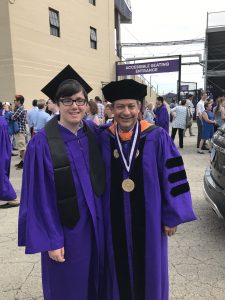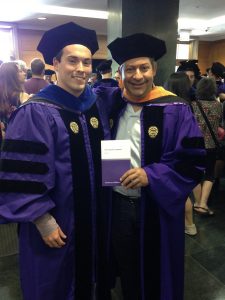Noshir will address the Web Science Summer School 2017 in St. Petersburg, Russia
Noshir Contractor participates on a panel at the Digital Innovation Networks Forum
Marlon Twyman presents two posters at NetSci 2017
SONIC graduate student, Marlon Twyman, presented two posters at the International School and Conference on Network Science (NetSci) 2017 held in Indianapolis, Indiana on June 19-23, 2017. One poster explores the integration of shared cognition, dynamic task networks, and agent-based modeling when studying collaboration within astronaut teams. The other poster investigates the performance of organizations when using various search strategies to find members of problem-solving teams.
Poster Citations:
Marlon Twyman, Leslie DeChurch, & Noshir Contractor. Using a Network Approach for Modeling Shared Cognition of Astronaut Teams. NetSci 2017 International School and Conference on Network Science, Indianapolis, Indiana, June 19-23, 2017. Twyman, M., Ma, L., Srivatsa, M., Cansever, D., & Contractor, N. Searching Networks to Assemble Teams. NetSci 2017 International School and Conference on Network Science, Indianapolis, Indiana, June 19-23, 2017.
Marlon Twyman, Liang Ma, Mudhakar Srivatsa, Derya Cansever, & Noshir Contractor. Searching Networks to Assemble Teams. NetSci 2017 International School and Conference on Network Science, Indianapolis, Indiana, June 19-23, 2017.
Diego Gomez-Zara presented two posters at NetSci 2017
On June 23rd, SONIC’s Ph.D. student Diego Gómez-Zará is going to present his research on social movements at the International School and Conference on Network Science (NetSci). This year, the conference will be hosted in Indianapolis, USA. Diego will present two posters “The role of social movement organizations and their leaders in Twitter: Evidence from the Chilean Student Movement” and “Using Relational Event Modeling to explain movements’ emergence in Twitter: Evidence from the Chilean Student Movement.”
New NASA Grant – Project FUSION
We are very excited to receive a new grant from NASA, on which SONIC’s Noshir Contractor is a Co-Investigator.
Project FUSION: Facilitating Unified Systems of Interdependent Organizational Networks
Project FUSION was among seven proposals, selected by NASA’s Human Research Program to help answer questions about astronaut health and performance during future long-duration missions beyond low-Earth orbit. These proposals will investigate the impact of the space environment on various aspects of astronaut health, including behavioral health and performance, cardiovascular alterations, human factors and radiation effects. All of the selected projects will contribute to NASA’s long-term plans for deep space exploration, including to Mars.
Project Team: Dorothy Carter, University of Georgia (PI), Marissa Shuffler, Clemson University (Co-I), Leslie DeChurch, Northwestern (Co-I), Noshir Contractor, Northwestern (Co-I), Aaron Schecter, University of Georgia (Co-I), Shawn Burke, University of Central Florida (Consultant), Stephen Zaccaro, George Mason University (Consultant), & Lauren Landon, Wyle Laboratories, Inc. (Consultant)
Sending a team of humans to Mars will require extreme forms of teamwork across complex “Multiteam Systems” comprised of multiple teams that are separated by unprecedented degrees of space and time (e.g., mission control teams, spaceflight crews). In “Project FUSION: Facilitating Unified Systems of Interdependent Organizational Networks” we will combine findings from qualitative research with NASA personnel, agent-based computational models, and laboratory studies at The University of Georgia, Northwestern University, and NASA analog environments to uncover the drivers of crucial psycho-social teamwork relationships, such as trust, influence, and shared understanding, within and across teams in Spaceflight Multiteam Systems. Based on this program of research, we will develop and deliver countermeasures, including training and debriefing protocols, to help NASA prepare for and monitor multiteam collaboration throughout long-duration space exploration missions.
Noshir Contractor was a plenary speaker at the Collective Intelligence Conference
Noshir Contractor gave a plenary talk in a session titled “Organizing and Organizations” at the Collective Intelligence Conference. CI is the fifth annual interdisciplinary conference dedicated to advancing our understanding of collective intelligence and the workings of groups. The conference took place at New York University’s Tandon School of Engineering in Brooklyn, NY, on June 15-16, 2017.
Congratulations to Brennan Antone for graduating with a BS and starting the Ph.D. program !!!
Congratulations to Brennan Antone for graduating with a BS in Industrial Engineering & Management Sciences (IEMS) and a minor in Psychology at Northwestern and joining the Ph.D. program in IEMS at Northwestern this Fall. Welcome back!!!

Congratulations to Dr. Aaron Schecter for graduating and starting a faculty position!
Congratulations to SONIC member, Dr. Aaron Schecter for graduating with a Ph.D. in Industrial Engineering & Management Sciences at Northwestern and starting as an assistant professor in the Department of Management Information Systems at the Terry College of Business, University of Georgia!!!

Noshir conducted a workshop at the 2017 SciTS Conference
Noshir Contractor was a lead facilitator of a workshop at the Science of Team Science (SciTS) Conference in Clearwater Beach, FL, held on June 12-14, 2017.
Network Perspectives to Understand and Enable Team Science
Description: In this workshop, attendees will be introduced to the basics of social network theories, methods, and tools. They will come away with an improved understanding of the various forms of networks necessary for effective scientific collaborations. This workshop is organized into three distinct parts. (1) The first part provides an historical overview of the motivations to view team science from a social networks perspective. This first part will conclude with a brief introduction to the concepts of social networks, cognitive social networks, knowledge networks, cognitive knowledge networks and their relevance to team science. (2) The second part focuses on using network metrics to describe team science. This part begins by defining various concepts used in network analysis: actors and attributes of actors, relations and properties of relations as well as two-mode networks. Next it describes various how these concepts influence strategies for the collection of network data. The session then defines and describes how various common network metrics are computed and interpreted at the actor, dyadic, triadic, sub-group, and component level. (3) The third part of the workshop addresses using network models to understand and enable team science. Here, a multi-theoretical multilevel (MTML) model is outlined to help stakeholders understand the dynamics for creating, maintaining, dissolving, and reconstituting social and knowledge networks in scientific communities. The session will provide a high level overview of statistical techniques to test MTML models of team science. Research exemplars are presented to illustrate the potential of the MTML framework to understand and enable team science. The session concludes with a demonstration of how these insights are being used to develop recommender systems for assembling effective scientific teams.
